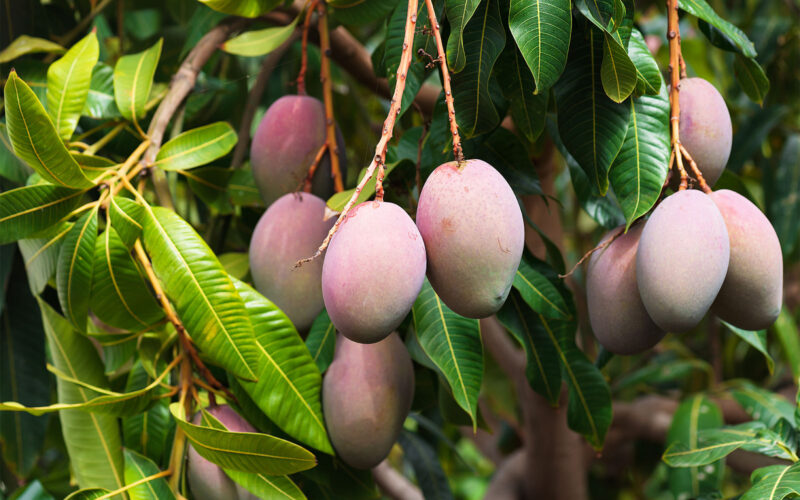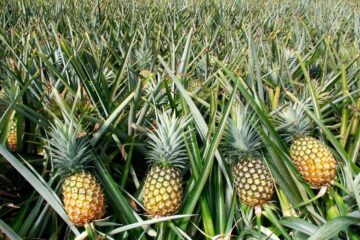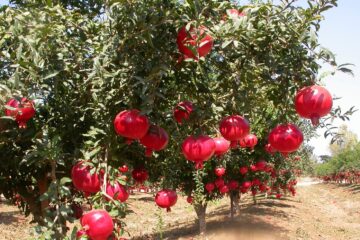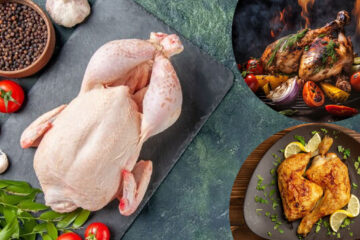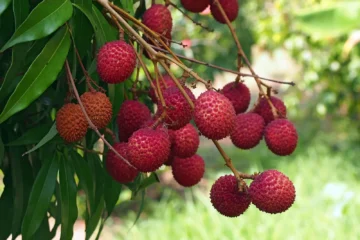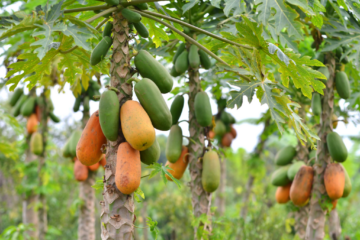Published: April 2017
Mango cultivation has been practiced in our country for approximately 4,000 years. The mango, often referred to as the “king of fruits,” holds a significant place in Tamil literature and is one of the three prized fruits mentioned in ancient texts. About 65% of the world’s mango production comes from India, and Tamil Nadu alone cultivates mangoes on approximately 130,000 hectares, yielding around 673,000 tons of fruit annually. This translates to an average yield of 5.18 tons per hectare. Major mango-producing districts in Tamil Nadu include Dharmapuri, Salem, Madurai, Theni, Dindigul, Vellore, and Chengalpattu.
Soil and Climate Requirements
Mango trees thrive in warm and semi-warm regions, growing well up to an elevation of 1,400 meters above sea level. The ideal temperature range is 21-27 degrees Celsius. During the flowering stage, it is crucial to avoid frost, heavy rainfall, and dense fog, as these conditions can cause flowers to drop, fruit to blacken, and increase the risk of pest and disease attacks.
Mango trees require dry conditions with high humidity at night to flower effectively. Excessive heat during the fruiting stage can cause the fruit to shrivel and fall off. Regions with an annual rainfall of at least 400 mm are suitable for mango cultivation.
The optimal soil pH ranges from 5.5 to 7.8. The soil should have a minimum depth of six feet and good drainage. Mango cultivation should be avoided in areas with high salinity, limestone content, or strong winds.
Mango Varieties
There are hundreds of mango varieties, but only 15-20 are widely cultivated. Some notable varieties and their regions include:
- Tamil Nadu: Neelum, Bangalora, Alphonso, Banganapalli, Imam Pasand, Rumani, Kalapadi, Senthooram
- Andhra Pradesh: Alampur, Baneshan, Banganapalli, Bangalora, Imam Pasand, Rumani, Kalapadi, Senthooram
- Karnataka: Alphonso, Bangalora, Mallika, Neelum, Pairi, Banganapalli
- Kerala: Mundappa, Olor, Pairi, Kilichundan, Moovandan
- Maharashtra: Alphonso, Sindhu, Ratna, Mankurad, Mallika, Pairi, Rajapuri, Kesar, Gulabi
Among these, Senthoora, Suvarnarekha, and Alphonso are early varieties. Banganapalli, Nadusalai, Imam Pasand, Mallika, Jhangir, Chinna Suvarnarekha, Kesar, and Salem Bangalora are mid-season varieties. Periyakulam 1 and 2, Ratna, Amrapali, Manjeera, Arka Aruna, Arka Puneet, Arka Neelakiran, Sindhu, Neeleshan, and Mallika are late-season varieties.
Propagation of Mangoes
Initially, mangoes were propagated using seedling methods, but this resulted in trees that did not retain the qualities of the parent tree. This method led to inconsistent yields and significant losses for farmers. To overcome this, vegetative propagation methods such as inarching, veneer grafting, and softwood grafting were developed. These methods are now widely used for producing high-quality saplings.
Planting Season
Mango trees can be planted in June-July or October-November. Dig pits of one-meter depth, width, and height and allow them to air for ten days. Burn dried leaves in the pits to eliminate harmful insects, their eggs, pest seeds, and larvae. Mix ten kilograms of decomposed manure with topsoil and fill the pits. Add 50 grams of a microbial mixture and 100 grams of Lindane 1.3% or Malathion 5% powder. Cover with another ten kilograms of manure, 100 grams of neem cake, 100 grams of superphosphate, and 100 grams of gypsum mixed with good soil. Plant the saplings in the center of the pits, ensuring that the graft union remains above ground level.
Spacing
Traditionally, mango trees were planted 10×10 meters apart, but now high-density planting is recommended. Trees are spaced 5×5 meters apart, accommodating 400 saplings per hectare. This method provides higher yields for up to 15 years. Proper pruning and training can prevent branches from intertwining and maintain yield efficiency.
Benefits of High-Density Planting
High-density planting allows for easy maintenance, harvesting, and the application of fertilizers and pest control measures. Proper care can ensure high-quality fruit production and maximize yield per unit area.
Fertilizer Management
Fertilization should begin with the onset of monsoon in June-July or August if rains are delayed. Apply fertilizers at a distance of 2-3 feet from the trunk, based on the tree’s age. Fertilizers should be split into two applications: June-August and October-November.
Fertilizer Schedule
- First Year: 10 kg manure, 0.2 kg nitrogen, 0.2 kg phosphorus, 0.3 kg potassium per tree.
- Up to Five Years: 10 kg manure, 0.2 kg nitrogen, 0.2 kg phosphorus, 0.3 kg potassium per tree.
- From the Sixth Year Onwards: 50 kg manure, 1 kg nitrogen, 1 kg phosphorus, 1.5 kg potassium per tree.
Apply microbial mixtures (100 grams per tree) 15 days before applying chemical fertilizers.
Micro Nutrient Management
Certain soil types may lack essential micronutrients. Zinc sulfate (0.3%) can be sprayed in February, March, and May. Borax and manganese deficiencies can be addressed by spraying borax (0.2-0.4%) and manganese sulfate (0.2-0.4%) solutions monthly. Magnesium sulfate (0.2-0.4%) and ferrous sulfate (0.2-0.3%) can be sprayed in February and April.
Organic Fertilizers
From the first year, apply 200 grams of bio-fertilizers per tree. Increase to 1,000 grams of bio-fertilizers per tree from the sixth year onwards.
Irrigation
Saplings require weekly irrigation, especially in dry conditions. Drip irrigation is ideal, providing 10-15 liters of water daily for young saplings and 30-50 liters for fruit-bearing trees. Irrigation should be halted during flowering to avoid excessive leaf growth. Irrigate every 10-15 days during the fruiting stage to enhance fruit size and quality.
Pruning
Proper pruning ensures better sunlight penetration, enhancing fruit quality and yield. Prune young trees to remove unwanted shoots. Mature trees should be pruned in August-September, removing dried, diseased, and crossed branches.
Flower Induction
To induce flowering in non-flowering trees by February, spray urea (5 grams per liter) or potassium nitrate (10 grams per liter). For off-season flowering, apply Paclobutrazol (2 ml per liter) around the root zone six months before flowering.
Pest and Disease Management
- Hopper: Spray imidacloprid (0.3 ml per liter) or neem oil (5 ml per liter) during flowering.
- Stem Borer: Treat by applying monocrotophos (10 ml) soaked in cotton to the bored hole and sealing with mud.
- Fruit Fly: Use methyl eugenol and malathion traps to attract and kill male flies.
- Leaf Webber: Spray carbaryl (2 grams per liter) or lambda-cyhalothrin (0.5 ml per liter) in March and April.
Diseases
- Powdery Mildew: Spray wettable sulfur (2 grams per liter) or carbendazim (1 gram per liter) at the onset of symptoms.
- Anthracnose: Spray carbendazim (1 gram per liter) or mancozeb (2 grams per liter) at 15-day intervals.
- Bacterial Leaf Spot: Apply streptomycin (0.5 gram per liter) mixed with copper oxychloride (2.5 grams per liter).
Harvesting
Harvest mangoes in the cool morning hours using a picking pole or basket to avoid damage. Cut the fruits with 10-20 cm of the stalk attached and place them upside down to drain the latex. Wash the fruits in running water to clean them before storage.
Post-Harvest Treatment
Dip fruits in hot water (52°C) for five minutes, then coat with 8% wax emulsion to prevent rot. Store at 7-9°C with 90% humidity to extend shelf life up to seven weeks.
Yield
Yield varies by variety, planting density, and tree age. Mature trees can produce 8-10 tons per hectare annually, while older trees can yield up to 15-20 tons per hectare.
Dr. C. Rajamanickam, Assistant Professor, Department of Horticulture, Agricultural College, Madurai – 625 104.

